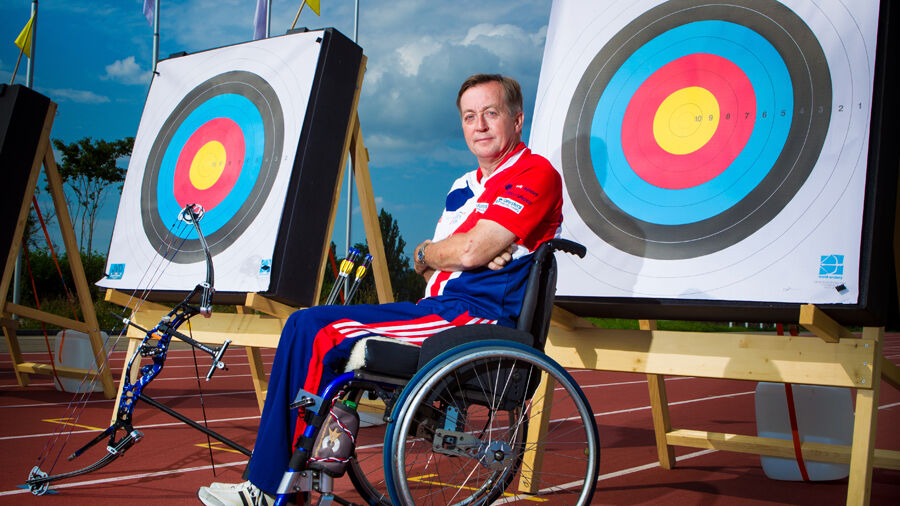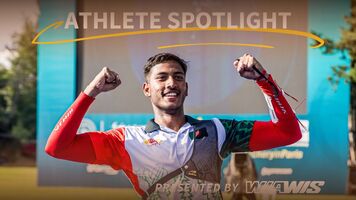John Cavanagh: 25 years in para archery, going for Rio 2016

But he’s quick to admit that it certainly doesn’t feel like that long since then, where he won the medal for Great Britain in the men’s W1 competition. Looking back at those Games, he remembers very early starts in the morning and long bus rides from the Paralympic village to the competition venue, the Helliniko Olympic Baseball Centre at the east coast of Greece.
According to John, winning the medal was a bit of a surprise. He didn’t have any great expectations following a challenging year, and only just achieving a quota place for the event.

“At the time I had no idea what the record was. It hadn’t even crossed my mind… so it was a bit of a surprise when it was announced. I guess it gave me some extra confidence going in to the rest of the tournament.”
“Despite having a nondescript ranking round I managed to get through the matches. I don’t remember much about the final, though. The semifinal against my old adversary Jeff Fabry, who was seeded number one after shooting a world record in qualification, seemed more crucial.”
Cavanagh had qualified in fifth place with 624 points for his 72 arrows, 43 behind Fabry’s world-record breaking 667. In their semifinal, both shot 108 for the 12-arrow match and it went to a one-arrow tiebreaker that John won, nine points to six.
The Brit then beat Anders Groenberg by a comfortable six points in the gold medal match.
After his success in Athens, Cavanagh collected silver at the 2008 Games in Beijing and was in the team for his home Paralympics at London 2012, where he reached the quarterfinals. Each of Games he has participated in has been a different experience, he says: “largely due to the volunteers, spectators and to the layout of the very different finals fields”.
During his home Games in London, a great number of spectators and volunteers were familiar to John. It created a homely atmosphere for the well-travelled veteran of international para archery competition.
London was also the Games where – for John – the Paralympics caught up in importance with the Olympics. “Both archery venues had capacity crowds throughout. Spectators genuinely wanted to be there and the ‘have a go’ areas had queues all day,” recalls the 58-years old athlete.
“This is a far cry from when I began. In Sydney there were plenty of empty seats and many spectators seemed to be groups of schoolchildren who stayed for just a short while before moving on to another sport.”
The appreciation of Paralympic sports generally in the United Kingdom as well as in the domestic archery community has increased dramatically since the London Games, according to John: “Before when we went off to the Games or a world or European Championships, it was with little outside interest. Only a few people had been at the field of play to actually see what is involved in para archery and how high the standard of international competition can be.”

At the beginning of October this year, John celebrated the International Paralympic Committee’s 25th anniversary at the organisation’s Membership Gathering in Berlin.
The IPC was founded in 1989, which was close to the time John’s life changed. During ski holidays near Rougemont in Switzerland, John fell down a cliff. The accident resulted in permanent damage of his spinal cord.
According to John, who before his accident had been working as research scientist investigating various aspects of the nervous system including neuro-muscular interactions, his injury “was certainly not as bad as it could have been, but resulted in reduced sensation and movement below about chest-level.”
It was after the accident that John became involved in archery: “I had no experience of the sport until 1989, when I was undergoing rehabilitation at the Stoke Mandeville Spinal Injuries Unit”
“It wasn’t straightforward as, apart from other problems, I had lost the use of my right hand. The physiotherapists rigged me up with a hook device to hold and release the string on a low-poundage recurve.”
“I joined a local club, shooting indoors once a week and through the British Wheelchair Archery Association met people with the necessary expertise in disability archery to enable me to progress further. I began going to outdoor tournaments, too – but it wasn’t until I managed to modify a release aid sufficiently that I took up shooting compound.”
At that time, John had no particular goal in archery. But one thing led to another and soon he was on his first trip abroad with the British para archery team, to the European Championships in France in 1995.
“One of the reasons that I took to the sport was that it is very individual. You can do it at your own pace without any obligations – compared to team sports, for example – and that fitted in well at that stage of my life,” explains John.
He describes himself as “a fairly relaxed kind of person”. Many around the world know him of nothing short of a true gentleman.
Archery might have had an important impact on that personality: “As a sport where technique counts above all else, there are endless improvements to make at any level. This makes it possible to put to one side the routine hassles of daily life, while concentrating on all the minutiae that make up a good shot. And trying to repeat it – the difficult part!”

Archery is one of the most integrated sports out there, according to John. Athletes of all abilities, levels, ages, impairments and ambitions are often found competing alongside each other. With only a few slight modifications made for para archery classification classes, para archers can achieve the same excellent athletic performances as any other archer – and compete on equal footing.
“There are plenty of examples of para archers progressing to the highest international levels,” says John. “Paula Fantano competed with the Italian teams at both the 1996 Atlanta Olympic and Paralympic Games, for example.”
“In many other sports such integration is not possible whether due to rules, equipment, governing bodies or simply that there may not be an equivalent non-impaired version. In a wider social context, archery can be looked upon as providing a good role model for inclusion regardless of individuals’ differences.”
As for John Cavanagh’s own archery – and what’s next in store for the four-time Paralympic athlete: “It’s an uncertain world, and it doesn’t take much to be either in or out of the team, so I only take one year at a time.”
“I would, of course, love to be in Rio in 2016. But before that we need to gain quota places. This process begins at the World Archery Para Championships in Germany next year, followed by a European event in 2016 – plus there’s the domestic selection process, too.”










